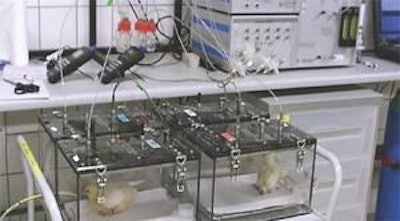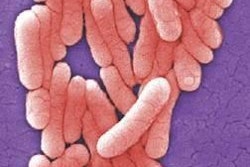
Nanotechnology has the potential to revolutionise many industries and its application has not escaped the attention of those working in agricultural research. A number of projects are currently taking place in Denmark that could, in different ways, contribute to more economical and healthier poultry production.
At the University of Copenhagen, work is being carried on "nanobiotics," particularly nanobiotic silver.
Silver and its ions have long been known to possess antibacterial properties but even in small doses, ionic silver may be toxic, limiting its use as an antibacterial agent in animal production.
Nanotechnological methods, however, allow silver nanoparticles (nanobiotic-Ag) to be produced, and these may have unique biological properties. By using nanobiotic-Ag, silver's toxicity could be minimised or eliminated while the risk of developing resistance and the transmission of resistant micro-organisms to humans through food products could also be greatly reduced.
It has been hypothesised that the antimicrobial properties of nanobiotic-Ag, when used in poultry nutrition, may affect microbial populations without inducing resistance. Additionally, nanobiotic-Ag may increase anabolic activity, leading to stimulation of development and growth of animals.
The University of Copenhagen's study combines areas of nanotechnology and biotechnology and includes measurements of several biochemical, microbiological, physiological and nutritional parameters carried out with embryos and growing chickens.
The university started preliminary research last year, although it has been collaborating with the University of Warsaw on silver microparticles since 2007.
Nanobiotics could be a substitute for antibiotics, including coccidiostats, and the university may be in a position to evaluate the possibilities of replacing coccidiostats by 2010. However, Professor Chwalibog of the university's Department of Basic Animal and Veterinary Sciences points out that the project is currently dealing with microbiological and immunobiological aspects of nanobiotic-Ag.
CHIP
Denmark is also home to another nanotechnology project with importance to the poultry industry, the Chicken and Hen Infection Protection project.
CHIP brings together 13 partners from the public and private sectors in a four-year initiative supported with DKK13.4 million (US$2.3 million) funding from the Danish Ministry of Science, Technology and Innovation.
The goal of CHIP is to break down bacterial disease pathways and reduce infections in poultry production. It aims to make use of the latest breakthroughs in nanotechnology and molecular biology. Its main focus is the optimisation of hygiene by testing new disinfection possibilities and by nanocoating select surfaces in poultry houses. The optimisation of drinking water systems is also being examined.
CHIP encompasses the investigation of pathogens and their influencing parameters, improving the hygiene of surfaces and housing, improving management procedures and producing models and risk-assessment tools. The project is looking at the effect of nanotechnology on bacterial population size and mutation rate, selection and disease patterns, with the aim of developing better prevention and treatment of diseases in large poultry populations.
As model organisms, Escherichis coli, a typical gram negative bacterium, is being used and is representative for salmonella and campylobacter. Enterococcus faecalis is the model for gram positive bacteria and is representative of enterococi, streptococci and staphylococci.
Nanocoating should make surfaces smooth on a nano-scale and this should result in improved cleaning and self-cleaning effects. The project is looking at designing equipment that has a high level of hygiene and is easier to clean, as well as new cleaning and disinfection procedures and agents to optimise cleaning between flocks.
As far as water systems are concerned, the project is looking at inhibiting the formation of biofilm and investigating parameters such as flow, temperature, materials and design.
Commenting on CHIP, spokesperson for the Danish Poultry Council Thorkil Ambrosen said: "With the participation of all important players in poultry production, and by using the latest scientific breakthroughs, this project will be of crucial importance for Danish poultry production."
Ventilation
Another Danish project is looking at the effects of coating ventilation fans with nanocoatings. Eight different coatings, including nano-silver, have been tested to gauge their impact on electricity consumption.
Up to 1cm of dust can accumulate on the blades of a ventilation system, reducing ventilation efficiency and increasing energy costs. A poultry farmer in Denmark might spend DKK100,000 (US$17,500) to DKK200,000 (US$35,000) on electricity each year and, in trials, some of the nanocoatings reduced electricity usage by 6%.
New Technology
Anders Iversen, consulting microbiologist with the Danish government's Institute for Agrotechnology and Food Innovation, explains: "We could apply this new technology and lower energy and CO2 emissions. Awareness of CO2 emissions is increasing in Denmark and agriculture is being encouraged to decrease its share. We want to see if applying this new technology is a shortcut to lower emissions."
Included in the trials were photovoltaic coatings that react to ultraviolet light. Without UV light, surfaces with these coatings are less active, their only activity being triggered by the UV component of normal light. Consequently, lighting applications need to be applied either constantly or at certain times.
Among the coatings tested was nano-silver, which does not require UV. Iversen explained that the ions from nano-silver prevent biofilms developing. It is these biofilms to which dust particles can stick and accumulate.
Experiments have already been carried out using coating supplied by a German paint manufacturer Bio+, which holds TUV certification for log 5 bacteria reduction of 99.99%. Fans can either be dip coated or sprayed and the cost of nanocoatings has come down enough to make their application practicable.
The benefits of nanotechnology are being recognised worldwide and while there may be some public reservations over the technology, a European Union study has found that concerns are lowest where health and medicine are concerned.
For the poultry industry, there may be big advantages to applying this small technology.


















